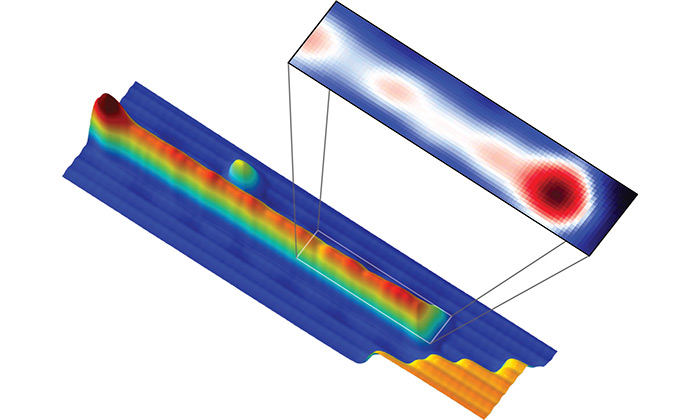Scientists at The University of Texas at Austin and Princeton University have observed an exotic particle that behaves simultaneously like matter and antimatter, a breakthrough that could eventually enable powerful computers based on quantum mechanics.
 Using a two-story-tall scanning-tunneling microscope, the scientists captured a glowing image of a particle known as a "Majorana fermion" perched at the end of an atomically thin magnetic wire.
Using a two-story-tall scanning-tunneling microscope, the scientists captured a glowing image of a particle known as a "Majorana fermion" perched at the end of an atomically thin magnetic wire.
The hunt for the Majorana fermion began in the earliest days of quantum theory shortly after physicists first realized that their equations implied the existence of "antimatter" counterparts to commonly known particles such as the electron. In 1937, Italian physicist Ettore Majorana predicted that a single, stable particle could be simultaneously matter and antimatter. Although many forms of antimatter have since been observed, the Majorana has remained elusive.
In addition to its implications for fundamental physics, the finding offers scientists a potentially major advance in the pursuit of quantum computing. In quantum computing, electrons are coaxed into representing not only the ones and zeroes of conventional computers but also a strange quantum state that is both a one and a zero. This strange property, called quantum superposition, offers the possibility of solving some problems previously thought to be impossibly difficult. However, quantum computing requires exceptional control over the environment with which the quantum states of interest interact, and this is extremely difficult to achieve.
Despite combining matter and antimatter, which usually leads to self-annihilation, Majorana fermions are remarkably stable quantum states that interact extremely weakly with their environment. This aloofness has spurred scientists to search for ways to engineer the Majorana into materials, which could provide a much more stable way of encoding quantum information, and thus a new basis for quantum computing.
The video shows how the researchers first deposited iron atoms onto a lead surface to create an atomically thin wire. They then used their microscope to map a signal that indicates the presence of the particle, called a Majorana fermion. The signal appeared at the ends of the wire. (Video courtesy of Ilya Dorzdov, Ali Yazdani Lab)
A team that included colleagues at Princeton and at the University of Texas at Austin published their results recently in the journal Science. The team had received a $3 million grant from the Office of Naval Research under a program called the Majorana Basic Research Challenge.
In addition to its potential practical impact on quantum computing in solid state materials, the pursuit of Majoranas could impact other areas of physics. Scientists believe, for example, that another group of sub-atomic particle called neutrinos, which also interact very weakly and are very hard to detect, could be a type of Majorana — a neutrino and anti-neutrino being the same particle.
In addition, scientists regard Majoranas as possible candidates for dark matter, the mysterious substance that is thought to account for most matter in the universe, but which has not been directly observed because it also does not directly interact with other particles.
Most of the previous thinking about generating solid state Majoranas using magnetism had focused on a strategy which should work in theory but was not practical, the researchers said.
The UT Austin-Princeton team succeeded using a creative new approach which did not require exotic materials. The successful experiments simply placed chains of iron atoms on lead, making the approach relatively straightforward for other scientists to reproduce and use.
"We realized that Majoranas could be present even with the common form of magnetism found in iron," said Allan MacDonald, a professor in the Department of Physics at The University of Texas at Austin.
Princeton’s Andrei Bernevig added, "As long as you have a strong magnetic material — like iron, but it could be a different magnet — in which electrons are magnetically polarized or electrons feel a very strong magnetic field, the possible range of parameters in which Majoranas appear increases dramatically. We expect many more materials will produce these elusive particles."
In fact, MacDonald added, "Iron and lead are almost certainly not the optimal materials. We expect to be able to identify materials in which Majoranas are even more stable. It might then be possible to design materials in which many Majoranas states are present and weakly coupled to troublesome environmental states. This is exactly what is needed as hardware for a quantum computer."
In addition to Bernevig and MacDonald, authors of the work include the team’s leader, Ali Yazdani of Princeton, and graduate student Ilya Drozdov, as well as postdoctoral researchers Stevan Nadj-Perge, Jian Li, Sangjun Jeon and Jungpil Seo of Princeton, and Hua Chen of The University of Texas at Austin.
Work at UT Austin was facilitated by computing facilities at the Texas Advanced Computing Center (TACC).
This piece was adapted from a Princeton University press release.

















Comments